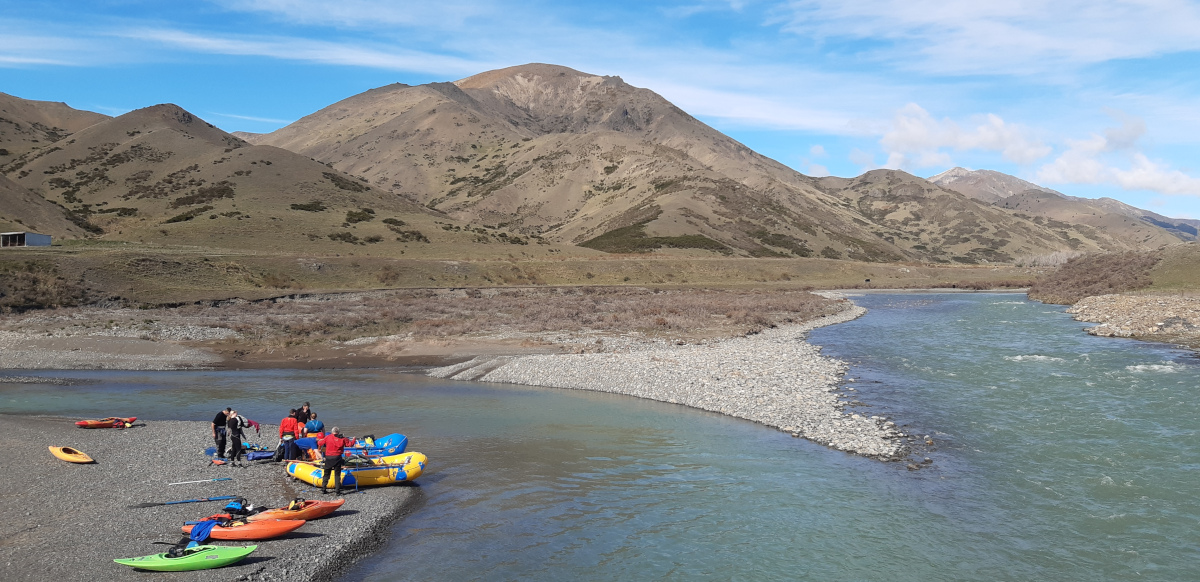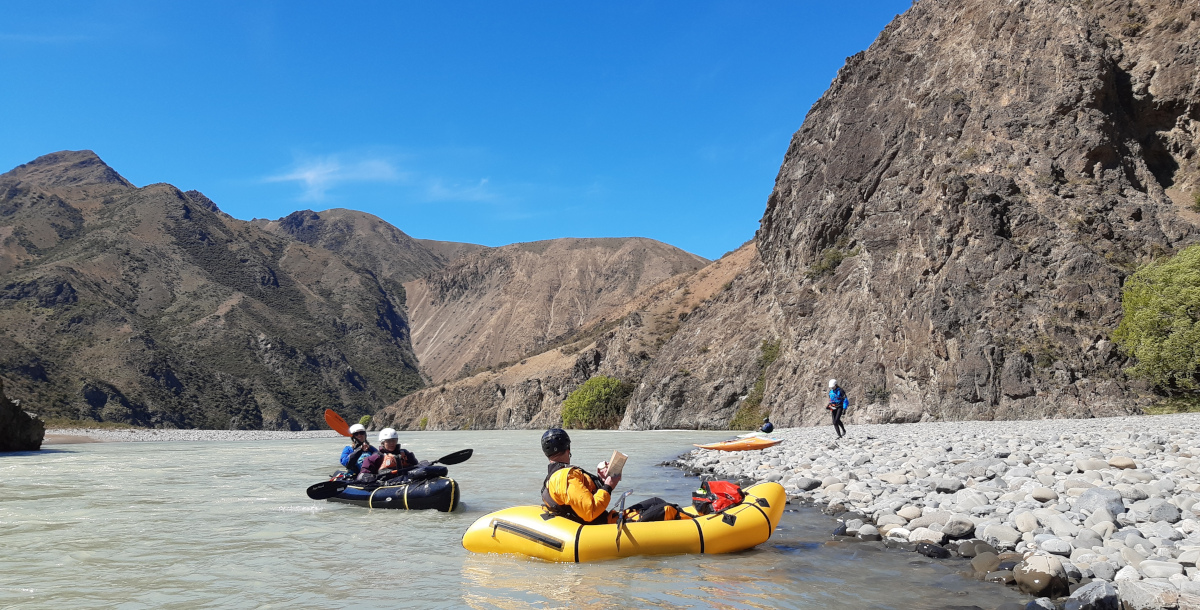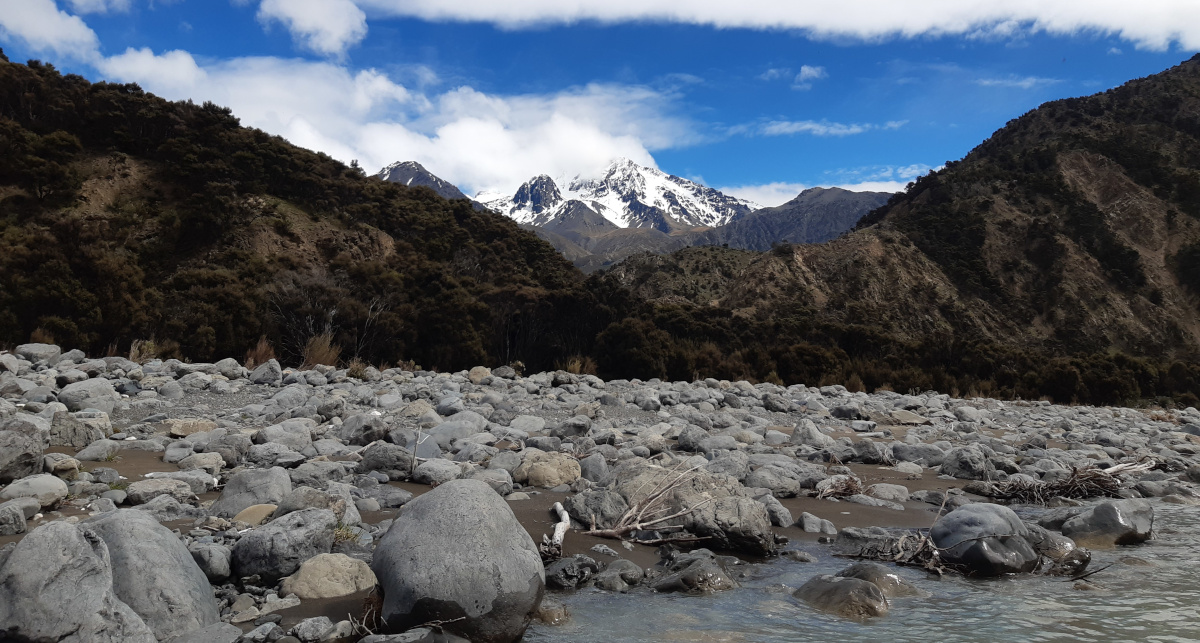Intro
2021 October 21-25, Waiau Toa (Clarence) River, New Zealand. 171km journey from Acheron to the Pacific Ocean.
When Hugh Canard announced to the Canterbury Whitewater Club (CWWC) members on second week of September that he was organising “Clarence River Labour Weekend 21 to 25 October” trip, I didn’t think twice and signed up for it.
According to Hugh, in terms of difficulty the river suppose to have a lot of G1, many G2, and some G3 rapids that aren’t scary and can be scouted and portaged. That sounded really good to me.
However, the 2016 Kaikoura earthquake has wrought substantial changes near Dart Stream, and between Glen Alton to the Pacific Ocean and as it turned out none of us have been on the river since the quake.
I started whitewater paddling in April 2019 and this would be my first multi-day overnight paddling trip and my first G3 trip. To date I only had G3 experience at the Tekapo Whitewater Course.
I decided to do the trip on my packraft. That way I can be fully self-sufficient. As a kayaker, I would rely on and add to the load of a gear raft. Packraft also feels more suitable for the five day backcountry trip and it is definitely more comfortable and stable than my kayak.
The Crew

1 x Raft: Heidi, Ian, Nick, Ruth
3 x Raft Rover: Hugh, John & Margaret, Merv
3 x Packraft: Greig, Marek, Mel & Shar
7 x Kayak: Alice, Colin, Jono, Julie, Justin, Liam, Thomas
The Flow
We had a nice and stable flow. During the five days we paddled the river, the flow dropped at Jollies from 25cumecs to 15cumecs, at Acheron from 51cumecs to 29cumecs, and at Clarence Valley Road Bridge from 189cumecs down to 131cumecs.
At the put in, we had 25cumecs @ 10am on 21 October 2021 @ Jollies, plus further 51cumecs from the Acheron confluence.
Waiau Toa / Clarence river at Jollies for the last 30 days ending when finished at 1pm on October 25th:
Waiau Toa / Clarence river at Jollies flow during our trip:
When we finished, we had 131cumecs / 1.69m stage height at 1pm on 25 October 2021 at the Clarence Valley Road Bridge.
Waiau Toa / Clarence river at Clarence Valley Road Bridge for the last 30 days ending when we finished at 1pm on October 25th:
Waiau Toa / Clarence river at Clarence Valley Road Bridge during our trip:
Getting There
Hugh organised a bus with a trailer to get us to the Acheron put in. The bus was also going to pick us up at Clarence Valley Road Bridge at the take out when we finished.
We were packed and on our way at 7pm on Wednesday 20th October 2021. We arrived at Acheron at 10.30pm, unloaded the trailer, setup camp, and called it a day.
Day 1
Time: 6.5h Start: 10:00am Elevation: 707m Distance: 26kms
The first day started with assembling the rafts, getting the gear raft packed, and for me setting my packraft with all my gear inside the tubes via the cargo tizip.
Off we went around 10.30am. We got to the first gorge and The Chute rapid (G3) after having lunch on the river bank. The Chute rapid was fun. With plenty of water in the river, the rapid was easier to get through. The geology of the gorge was fantastic. I have never seen anything like it.
The rest of paddling during the day was a lot of G1 and G2 rapids. I swam once when I fell into a stopper that I didn’t see. I swam to the shallow side of the river and hopped back into my packraft and continued paddling. I learned a great river-reading lesson which I used mostly successfully during the rest of the trip.
After the first gorge, we finished at the Big Eddy camp and called it a day. It was quite cold so we made a fire, setup our camp, cooked dinner, and sat around the fire for a couple of hours.

Day 2
Time: 6h Start: 9:45am Elevation: 620m Distance: 30kms
The night was chilly at the Big Eddy camp, but sleep was comfortable on the sand among the willow trees.
The second day was a pleasant one with easy G1 and some G2 rapids with no swims.
We paddled through the second gorge until the valley opened up down to Quail Flat and we camped there.
Merv joined us there to paddle the river for three days from there to the Pacific Ocean.
Nick shot a wild goose and made goose curry which we all tried.

Day 3
Time: 8h Start: 9:45am Elevation: 475m Distance: 34kms
We had cold-ish start of the day, but it warmed up around lunch time and stayed nice and warm for the rest of the trip. We had nice and enjoyable day on the river again.
At one point, we passed another party of commercial rafters that were doing the river at the same time as us. They passed us when we stopped for our lunch. After lunch, we continued down the river.
I was at the end of our group and after one of the many bends, I noticed that Greig pulled into an eddy and jumped off his packraft. I thought that was a bit odd so I slowed down and waited for him.
On the river bank, the other party stopped for lunch. I waved at them and kept an eye on Greig. He pulled out and was on the true left bank just before yet another bluff bend right.
Everyone else was already ahead of me so I decided to catch up with the rest and ask the group to stop and wait for Greig.
Gladly, Colin decided to do some raft paddling on Hugh’s raft so everyone eddied out and waited whilst Colin was strapping his boat onto the raft.
I said that Greig stopped and was behind us as the last paddler of our group and that I saw him getting out of his boat and getting on the river bank approximately kilometer above us.
After a bit of discussion, we decided that I would go back up the river on foot. I ferried to the other side and started pulling my packraft up the river using my flip line. I made a couple of hundred meters up the river when the other party passed us.
I asked them whether they saw Greig. They did. They made a whistle signal, but he signalled back OK so they left him there. I went back downstream to rejoin the rest of our crew for further discussion.
We decided to have Merv on raft, Jono in kayak, and myself as a packrafter to wait for Greig and the rest should continue down.
After another 20 minutes there was still no sign of Greig. The three of us decided that if he wouldn’t show up within another 10 minutes, I would start walking up the river bank to him again.
Gladly, I spotted him paddling down the river furiously shortly after. Something was odd about his packraft. His bow was high up, the packraft was trying to fold itself in half.
When he got to us, he said that he sliced his boat against a sharp rock which is why he ended up pulling into eddy and out of his boat. He taped the boat and inflated it enough so that he can paddle fast to catch up with us.
Luckily, I saw him when this happened and we were waiting for him. We put his packraft on Merv’s raft where he became a passenger and we continued down to catch up with others.
This was a good lesson for the whole crew and from that point as a group we started paying more attention to how we’re running the river.
End of the day saw us getting to Dambuster G3 rapid that was created by the quake. We scouted and ran it. I managed to not handle one of the lateral waves so I flipped and went for a swim and practiced self rescue. That was a bit of type 2 fun.
We had less than a kilometer until the camp so we continued only to discovered another quake-made rapid around the corner just before the camp.
I couldn’t figure out the line so I decided to boof a rock in the middle of the river with two holes on each side. That was fun. Somehow I didn’t end up swimming and a few minutes later we stopped at our next camp.
We had an exciting day and everyone thought that we were done. Nope. As we set up our camp, Colin came to us and said that he needs to trigger S.O.S. on his inReach and call a helicopter. Turns out that Margaret had a little misadventure whilst portaging the Dambuster rapid and her knee got a bit munted.
Thirty minutes after triggering S.O.S., a rescue helicopter flew in from Nelson. We were amazed by the fast rescue service response time. Margaret got attended by medics and flew away to Blenheim hospital as it was getting dark. What a day!

Day 4
Time: 6.5h Start: 9:45am Elevation: 320m Distance: 24kms
After the Greig’s adventure of turning his packraft into the Titanic, we debriefed and set up a way how we were going to run the river. Rafters, kaykers, and packrafters discussed their strategy of looking after each other on the river.
Within an hour on the river, we started experiencing swims as the water became harder. The Jawbreaker rapid was a rather gentle wave train. Not as hard as it used to be. We felt really confident, because this was suppose to be hard and it wasn’t.
However, after the next bend, there was another rapid that none of us knew about. G3, big hole right in the middle of the river. As I approached it, John and Merv on their rafts were in front of me. This is when the carnage fully unfolded.
John’s raft turned to side and got stuck in the hole. With John almost falling off it, Merv’s raft went into the same hole and pushed John and his raft out of it. Merv’s raft almost flipped and Merv fell off it, somehow leaving only his dog, Max, on the raft navigating it around the next bluff alone.
I tried to slow down so that I did’t end up under Merv’s raft. Watching the carnage and slowing down was a terrible idea. I didn’t figure out a safe line through this mess and I had no speed. I ended up falling into the same hole myself. It swallowed me for breakfast. I got spewed out shortly after, somehow with my paddle in my hand and still holding on to my packraft. I started swimming to the side of the river.
In the meantime, Ruth heroically jumped from their paddle raft into Merv’s raft and helped Max with getting the raft into an eddy. I ended up on the river bank a few hundred meters below, just before the next bend and rapid. This was type 2 fun indeed.
The day was nowhere close to being over and we saw some surprise holes on both sides of the river swallowing packrafts and kayaks. I managed not to fall into any further stopper myself, but I passed by as others fell in and watched the carnage unfolding in front of me.
I stopped counting team swims at number 12, but I don’t think we got to 20. Or did we? Does a double packraft swim count as one or two swims?
I cannot recall when we ran Nosebasher rapid, because with our flow the usual rapids were different. This was a tough day with some nice G3 technical water with new features created by the quake and the high flow.
We were doing really well as a team, glued together by looking after each other and saving each other as we went for swims.
Apart from my “big hole” swim, I had one more in a pushy boil which was totally avoidable if only I paid more attention and wasn’t tired.
Wind picked up in the afternoon. Probably the first time on the trip when we had to push against it. The wind only worked against us until we made the turn back to the Pacific Ocean and it changed to tail wind and started helping out.
Hugh decided to stop for a camp one camp earlier than he originally planned, because we all had enough. It was a big day.

Day 5
Time: 4h Start: 9:15am Elevation: 142m Distance: 25.5km
On our last day, we had yet another day of splendid, warm weather. Blue sky, no clouds, no wind. Just beautiful. Shortly after we started, we went out of the endless bends of the river and entered its wide, braided section on the shore side of the Kaikoura mountain range.
The flow was almost unchanged, our day was going great. This was a nice and mellow G1, without any hidden surprises.
After lunch, we got to the Wharekiri Bluff where the Papatea Fault rapids started. The river was diverted north by a massive fault which uplifted the whole valley floor up to 6m at Limestone Hill.
This created a series of wave train rapids that were a lot of fun to ride. Ever better, we got through them without a swim.
Shortly after 1pm, we saw a SH1 bridge with traffic and we knew we were close to the finish. One last wave train and we were at the SH1 bridge at the take out on the true left just after the bridge.

Outro
Five days of beautiful river, great crew, solid flow, splendid weather with almost no wind, solid G2 and some funky G3. I don’t think it could’ve been any better.
This one goes into my books as one the best trips I have ever been to and the best trip of 2021.
Thank you Hugh for organising. This was a memorable trip.
Comments
comments powered by Disqus